People
Dasha Zhukova’s New Garage Museum Delivers Social Engagement But No Politics
The bar is set high for Garage, vying for influence locally and internationally.

Photo: courtesy Garage Museum
The bar is set high for Garage, vying for influence locally and internationally.

Hili Perlson

The Garage Museum for Contemporary Art is opening the doors of its new permanent home at Gorky Park to the public tomorrow. The building—formerly a restaurant built in 1968 in the generous Soviet style saved for public buildings and complete with mosaics—was in disarray when Rem Koolhaas’s OMA started devising plans for its re-functioning (see Dasha Zhukova Opens Rem Koolhaas-Designed Garage Museum of Contemporary Art In Moscow).
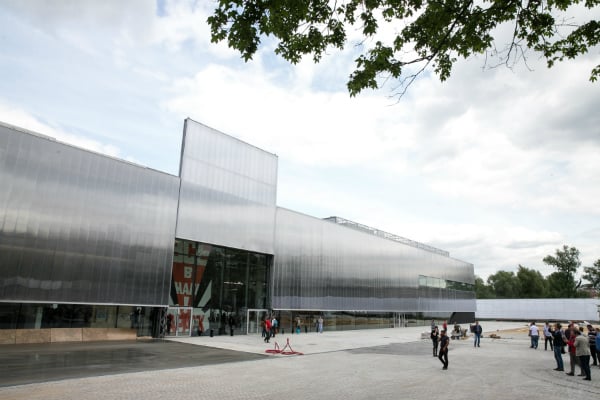
Garage Museum designed by Rem Koolhaas, view of the entrance.
Photo: Courtesy Garage Museum
The structure was enclosed with a new facade made of translucent polycarbonate—a new “skin” as OMA refers to it—which cleverly gives off the reflective sleekness seen in much of today’s mega projects by star architects, but executed instead with simple, low-cost materials. The facade’s form and function make the most out of Garage’s location, as the skies and surrounding park are reflected in it.
But, more importantly, it references the ideas of the original structure and the era that it grew out of: referred to as “the black hole of preservation” architecture from the 1960s and 70s, it represents ideas and approaches that are publicly and socially driven, that are meant to serve the public, and are cheap and fast to construct. (See Dasha Zhukova to Debut Moscow’s Rem Koolhaas–Designed Garage Museum June 12.)
How are these ideas reflected in the museum’s interior? At a preview on June 10, it was clear that much of it is hardly finished. The press conference, held beneath the building’s centerpiece, a mosaic from the original restaurant, was occasionally disturbed by the heavy machinery operated by the builders who were working around the clock to complete the pathways around the building and a concrete deck by the entrance before the opening event that same evening.
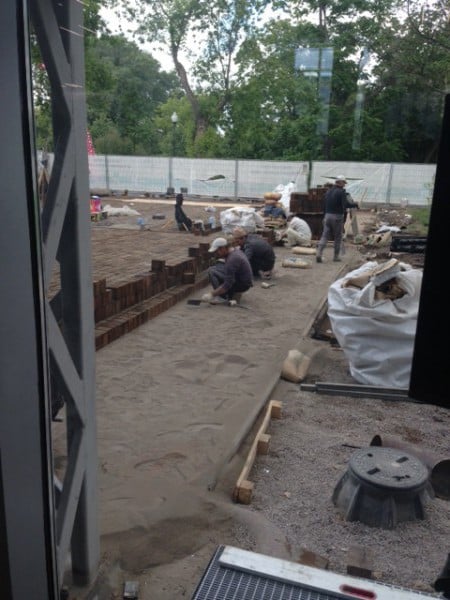
Construction workers were still working on the pathways around the building.
Photo: artnet News
This opposition, though simply candid (who knew cement can be poured, leveled, polished, and then trodden upon with Louboutins, without the stilettos leaving tiny marks in the path, all in less than 12 hours?) could symbolically stand in for the questions surrounding some of the choices made for Garage Museum. There were official narratives to every aspect of the institution, from its name to its design to the curation and future programs—but also little willingness to divert from those narratives, though the sweat, the process, and the incompleteness were plain to see.
“In 2007, when we came up with an idea to create an art institution in Moscow I could never have imagined that Garage would became what it is today,” Zhukova told the press.
Rem Koolhaas, for his part, stressed the life-changing effect that a formative visit to Moscow in the late 60s—when he was still working as a journalist—had on him: “I saw the work of Soviet and modern Russian architects and realized that architecture could be … an art that shapes possibilities and the nature of life. Once I realized that, I decided to become an architect.”

Yayoi Kusama wrapped trees around the museum as part of her first show in Moscow, at Garage.
Photo: Courtesy Garage Museum
OMA’s engagement with the project of preservation was “a process enabling a different kind of use,” he said. “We showed respect for what was there, and accepted those givens without having to invest in vanity or spectacle.” The most radical change to the floor design was creating a two-story height atrium at the entrance that will be dedicated to showing large scale commissions. The inaugural work is a double-sided painting by Erik Bulatov in the style of constructivist posters, that reads “Come to Garage!”
Those who will indeed come to Garage will find immersive works by Yayoi Kusama, the artist’s first show in Moscow, tucked away behind a large space dedicated to ping-pong tables and pelmeni cooking stations by Rirkrit Tiravanija (see Yayoi Kusama Is the Most Popular Artist in The World and Why Are Yayoi Kusama’s Works Selling Like Hotcakes? ).
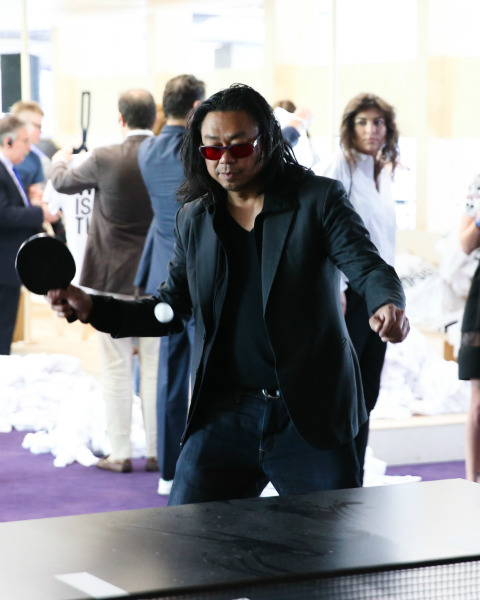
Rirkrit Tiravanija, in his show “Tomorrow is the question”
Photo: Courtesy Garage Museum
Tiravanija appears to be citing the work of late Slovakian artist Julius Koller—presented without any comments on the links between the two in an adjacent room—who engaged in what he called “cultural situations” in the 1970s.
Taryn Simon presented a cavity the size of Malevich’s black square carved in concrete on a wall by the museum’s gift shop. The work, entitled Black Square XVII, is the product of the first collaboration ever between Russia’s State Nuclear Energy Corporation (ROSATOM) and an artist. The artwork is—or will be—made from nuclear material, which is now vitrified in a facility where it will stay for approximately 1,000 years until it is no longer radioactive. In the year 3015, a black square made from the nuclear waste will be permanently displayed inside the void integrated into the new museum building.
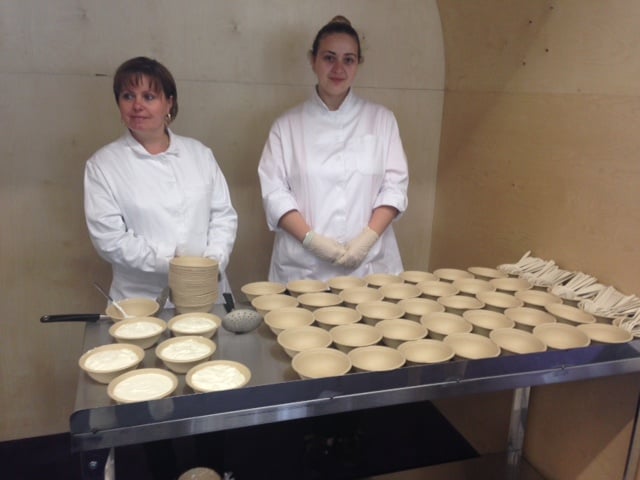
Pelmeni station as part of Rirkrit Tiravanija’s show “Tomorrow is the question”
Photo: artnet News
Visitors will also have to do a lot of reading (see Garage Museum Reveals Hidden History of Russian Art). As a museum with an archive collection and a strong educational mission statement, Garage’s focus is not only set on bringing international contemporary art to Moscow as the city’s first contemporary museum, but also “on producing internationally important projects from Moscow,” as chief curator Kate Fowle put it, reiterating the statement made by Anton Belov, the museum’s director.
The institution’s concept of engaging with its public is certainly influenced by Claire Bishop’s ideas on museology, and interestingly, one of the museum’s projects is the translation into Russian of important theoretical texts, including Bishop’s. But presenting the whole scope of Garage Museum’s program in an inaugural exhibition is no small feat, and demands that viewers take as givens the needs and gaps in the contemporary Russian art world defined by Garage’s team.
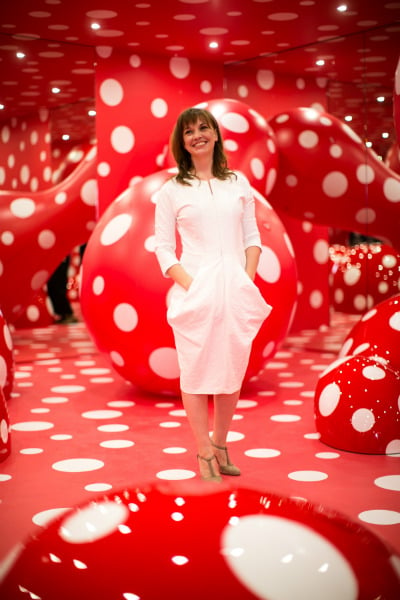
Garage chief curator Kate Fowle
Photo: Courtesy Garage Museum
A project to map out the family tree of contemporary Russian art can only hint at the massive archival and research efforts launched by the institution. However, with many of the shows on view centered on the presentation of ephemera—from the four research programs to the photographs of Moscow’s 1970s and 1980s underground art scene by conceptualist George Kiesewalter—they are ambitious in their demand of visitors’ attention.
The attention of journalists seemed to be tested as well. At the press conference, a member of the Russian press wanted to shift away from discussing the museum’s educational efforts and get down to business: What designer was Dasha wearing? Ms. Zhukova smiled and politely diverted, but Koolhaas jumped in to stress that Dasha was “a sharp and brilliant critic of architecture.”
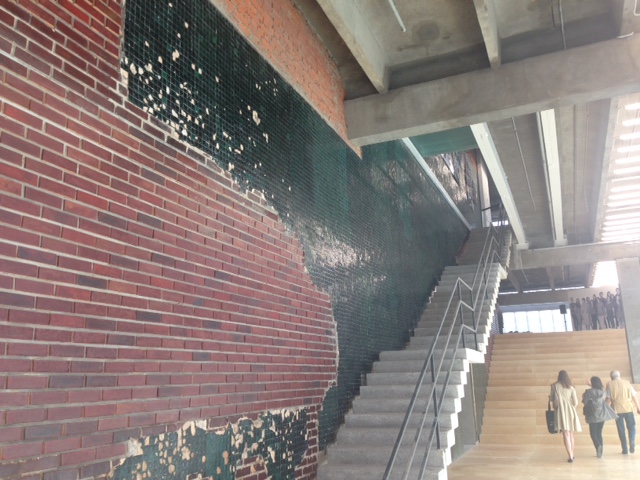
A view of conserved wall of tiles at Garage Museum, Moscow
Photo: artnet News
Koolhaas also replied to the question on everybody’s minds: What was the difference between Garage and the recently opened Prada Foundation in Milan?
“While Prada was the making of many different entities into a single whole, here we had a single whole into which we had to insert many different conditions, so to some extent that’s a direct opposite,” he said (see Rem Koolhaas Designed Prada Foundation Opens in Milan on Eve of Venice Biennale, Take a Look Inside Miuccia Prada and Patrizio Bertelli’s New Fondazione Prada and 8 Must-See Rem Koolhaas Designed Art Spaces around the World).
“The Prada Foundation is a kind of fortress and this one is a part of the city,” Koolhaas explained. “What we promote here is the connection to the public.”
Muscovites will surely connect with the building, if only for its location in the heart of Gorky Park. Whether visitors will engage with the narratives contained within, which could fill gaps one might never knew existed, is another question. But a strong aspect of the Garage Museum is the process. How it will unfold, only time can tell.
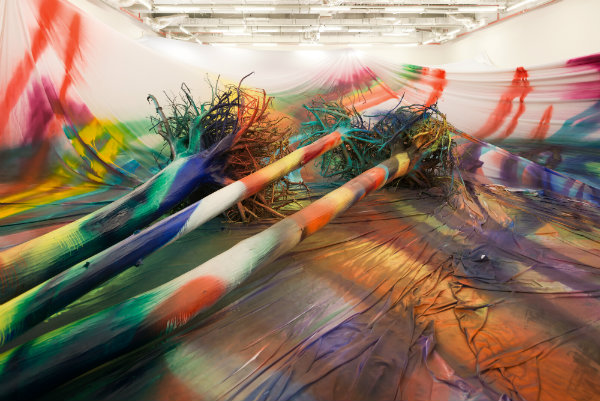
Katharina Grosse, yes no why later (2015) installed inside a temporary pavilion.
Photo: Ilya Ivanov. Courtesy Garage Museum of Contemporary Art, Katharina Grosse and VG Bild-Kunst, Bonn, 2015
Courtesy of Galerie nächst St. Stephan/ Rosemarie Schwarzwälder, Vienna and Johann König, Berlin
The Garage Museum of Contemporary Art, Moscow, opens to the public June 12.